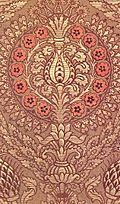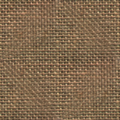Silk
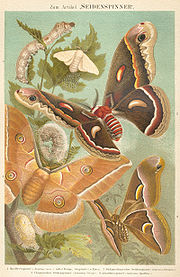

Silk is a natural protein fibre, some forms of which can be woven into textiles. The best-known type of silk is obtained from cocoons made by the larvae of the mulberry silkworm Bombyx mori reared in captivity (sericulture). The shimmering appearance for which silk is prized comes from the fibers' triangular prism-like structure which allows silk cloth to refract incoming light at different angles.
"Wild silks" are produced by caterpillars other than the mulberry silkworm and can be artificially cultivated. A variety of wild silks have been known and used in China, South Asia, and Europe since early times, but the scale of production was always far smaller than that of cultivated silks. They differ from the domesticated varieties in color and texture, and cocoons gathered in the wild usually have been damaged by the emerging moth before the cocoons are gathered, so the silk thread that makes up the cocoon has been torn into shorter lengths. Commercially reared silkworm pupae are killed by dipping them in boiling water before the adult moths emerge, or by piercing them with a needle, allowing the whole cocoon to be unraveled as one continuous thread. This permits a much stronger cloth to be woven from the silk. Wild silks also tend to be more difficult to dye than silk from the cultivated silkworm.
There is some evidence that small quantities of wild silk were already being produced in the Mediterranean area and the Middle East by the time the stronger, cultivated silk from China began to be imported (Hill 2003, Appendix C).
Silks are produced by several other insects, but only the silk of moth caterpillars has been used for textile manufacture. There has been some research into other silks, which differ at the molecular level. Silks are mainly produced by the larvae of insects that complete metamorphosis, but also by some adult insects such as webspinners. Silk production is especially common in the Hymenoptera (bees, wasps, and ants), and is sometimes used in nest construction. Other types of arthropod produce silk, most notably various arachnids such as spiders (see spider silk).
Contents |
History
China

Silk fabric was first developed in ancient China, possibly as early as 6000 BC and definitely by 3000 BC. Legend gives credit for developing silk to a Chinese empress, Xi Ling-Shi (Hsi-Ling-Shih, Lei-tzu). Silks were originally reserved for the Kings of China for their own use and gifts to others, but spread gradually through Chinese culture both geographically and socially, and then to many regions of Asia. Silk rapidly became a popular luxury fabric in the many areas accessible to Chinese merchants because of its texture and luster. Silk was in great demand, and became a staple of pre-industrial international trade. In July 2007, archeologists discovered intricately woven and dyed silk textiles in a tomb in Jiangxi province, are dated to the Eastern Zhou Dynasty, roughly 2,500 years ago.[1] Although historians have suspected a long history of a formative textile industry in ancient China, this find of silk textiles employing "complicated techniques" of weaving and dyeing provides direct and concrete evidence for silks dating before the Mawangdui-discovery and other silks dating to the Han Dynasty (202 BC-220 AD).[1]
The first evidence of the silk trade is the finding of silk in the hair of an Egyptian mummy of the 21st dynasty, c.1070 BC [2]. Ultimately the silk trade reached as far as the Indian subcontinent, the Middle East, Europe, and North Africa. This trade was so extensive that the major set of trade routes between Europe and Asia has become known as the Silk Road.
The Emperors of China strove to keep knowledge of sericulture secret to maintain the Chinese monopoly. Nonetheless sericulture reached Korea around 200 BC, about the first half of the 1st century AD had reached ancient Khotan[2], and by AD 300 the practice had been established in India.
Thailand
Silk is produced in Thailand's most favorable climate by two types of silkworms, the cultured Bombycidae and wild Saturniidae, all the year round, mostly after the rice harvest by villagers from the southern and northeast parts of the country. Women traditionally weave silk on hand looms, and pass the skill on to their daughters as weaving is considered to be a sign of maturity and eligibility for marriage. Thai silk textiles often use complicated patterns in various colors and styles. Most regions of Thailand have their own typical silks. A single thread filament is too thin to use on its own so Thai women combine many threads to produce a thicker, usable fiber. They do this by hand-reeling the threads onto a wooden spindle to produce a uniform strand of raw silk. The process is a tedious one as it takes nearly 40 hours to produce a half kilogram of Thai silk.
In today's Thailand, many local operations use a reeling machine for this task, but there are silk thread that are still hand-reeled. The difference is that hand-reeled threads produce three grades of silk: two fine grades that are ideal for lightweight fabrics and a thick grade for heavier material.
The silk fabric is then soaked in hot water and bleached before dyeing in order to remove the natural yellow coloring of Thai silk yarn. To do this, skeins of silk thread are immersed in large tubs of hydrogen peroxide. Once washed and dried, the silk is then woven using a traditional hand operated loom. [3]
India
Silk, known as Pattu in southern parts of India and Resham in Hindi/Urdu (from Persian), has a long history in India and is widely produced today. Historically silk was used by the upper classes, while cotton was used by the poorer classes. Today silk is mainly used in Bhoodhan Pochampally (also known as Silk City), Kanchipuram, Dharmavaram, Mysore, etc. in South India and Banaras in the North for manufacturing garments and sarees. "Murshidabad silk", famous from historical times, is mainly produced in Malda and Murshidabad district of West Bengal and woven with hand looms in Birbhum and Murshidabad district. Another place famous for production of silk is Bhagalpur. The silk from Kanchi is particularly well-known for its classic designs and enduring quality. The silk is traditionally hand-woven and hand-dyed and usually also has silver threads woven into the cloth. Most of this silk is used to make saris. The saris usually are very expensive and vibrant in color. Garments made from silk form an integral part of Indian weddings and other celebrations. In the northeastern state of Assam, three different types of silk are produced, collectively called Assam silk: Muga, Eri and Pat silk. Muga, the golden silk, and Eri are produced by silkworms that are native only to Assam. The heritage of silk rearing and weaving is very old and continues today especially with the production of Muga and Pat riha and mekhela chador, the three-piece silk saris woven with traditional motifs. Mysore Silk Sarees, which are known for their soft texture, last many years if carefully maintained.
Ancient Mediterranean
In the Odyssey, 19.233, it is mentioned that Odysseus wore a shirt "gleaming like the skin of a dried onion" (varies with translations, literal translation here[4], while pretending to be someone else, addressing himself to his wife Penelope. The Roman Empire knew of and traded in silk. During the reign of emperor Tiberius, sumptuary laws were passed that forbade men from wearing silk garments, but these proved ineffectual.[5] Despite the popularity of silk, the secret of silk-making only reached Europe around AD 550, via the Byzantine Empire. Legend has it that monks working for the emperor Justinian I smuggled silkworm eggs to Constantinople in hollow canes from China. All top-quality looms and weavers were located inside the Palace complex in Constantinople and the cloth produced was used in imperial robes or in diplomacy, as gifts to foreign dignitaries. The remainder was sold at very high prices.
Islamic world
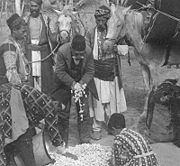
In Islamic teachings, Muslim men are forbidden to wear silk. Many religious jurists believe the reasoning behind the prohibition lies in avoiding clothing for men that can be considered feminine or extravagant.[6] Despite injunctions against silk for men, silk has retained its popularity in the Islamic world because of its permissibility for women. The Muslim Moors brought silk with them to Spain during their conquest of the Iberian Peninsula.
Medieval and modern Europe

Venetian merchants traded extensively in silk and encouraged silk growers to settle in Italy. By the 13th century, Italian silk was a significant source of trade. Since that period, the silk worked in the province of Como has been the most valuable silk in the world. The wealth of Florence was largely built on textiles, both wool and silk, and other cities like Lucca also grew rich on the trade. Italian silk was so popular in Europe that Francis I of France invited Italian silk makers to France to create a French silk industry, especially in Lyon. Mass emigration (especially of Huguenots) during periods of religious dispute had seriously damaged French industry and introduced these various textile industries, including silk, to other countries.
James I attempted to establish silk production in England, purchasing and planting 100,000 mulberry trees, some on land adjacent to Hampton Court Palace, but they were of a species unsuited to the silk worms, and the attempt failed. British enterprise also established silk filature in Cyprus in 1928. In England in the mid 20th Century, silk was produced at Lullingstone Castle in Kent. Silkworms were raised and reeled under the direction of Zoe Lady Hart Dyke. Production started elsewhere later. In Italy, the Stazione Bacologica Sperimentale was founded in Padua in 1871 to research sericulture. In the late 19th century, China, Japan, and Italy were the major producers of silk. The most important cities for silk production in Italy were Como and Meldola [7] (Forlì). In medieval times, it was common for silk to be used to make elaborate casings for bananas and other fruits.
Silk was expensive in Medieval Europe and used only by the rich. Italian merchants like Giovanni Arnolfini became hugely wealthy trading it to the Courts of Northern Europe.
North America
James I of England introduced silk-growing to the American colonies around 1619, ostensibly to discourage tobacco planting. Only the Shakers in Kentucky adopted the practice. In the 1800s a new attempt at a silk industry began with European-born workers in Paterson, New Jersey, and the city became a US silk center, although Japanese imports were still more important.
World War II interrupted the silk trade from Japan. Silk prices increased dramatically, and US industry began to look for substitutes, which led to the use of synthetics such as nylon. Synthetic silks have also been made from lyocell, a type of cellulose fiber, and are often difficult to distinguish from real silk (see spider silk for more on synthetic silks).
Properties
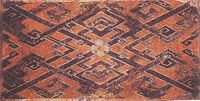
Physical properties
Silk fibers have a triangular cross section with rounded corners. This reflects light at many different angles, giving silk a natural shine. It has a smooth, soft texture that is not slippery, unlike many synthetic fibers. Its denier is 4.5 g/d when dry and 2.8-4.0 g/d when wet.
Silk is one of the strongest natural fibers but loses up to 20% of its strength when wet. It has a good moisture regain of 11%. Its elasticity is moderate to poor: if elongated even a small amount it remains stretched. It can be weakened if exposed to too much sunlight. It may also be attacked by insects, especially if left dirty.
Silk is a poor conductor of electricity and thus susceptible to static cling.
Unwashed silk chiffon may shrink up to 8% due to a relaxation of the fiber macrostructure. So silk should either be pre-washed prior to garment construction, or dry cleaned. Dry cleaning may still shrink the chiffon up to 4%. Occasionally, this shrinkage can be reversed by a gentle steaming with a press cloth. There is almost no gradual shrinkage or shrinkage due to molecular-level deformation.
Chemical properties
Silk is made up of the amino acids GLY-SER-GLY-ALA-GLY and forms Beta pleated sheets. Interchain H-bonds are formed while side chains are above and below the plane of the H-bond network.
The high proportion (50%) of glycine, which is small, allows tight packing and the fibers are strong and resistant to stretching. The tensile strength is due to covalent peptide bonds. Since the protein forms a Beta sheet, when stretched the force is applied to these strong bonds and they do not break.
Silk is resistant to most mineral acids but will dissolve in sulfuric acid. It is yellowed by perspiration.
Uses
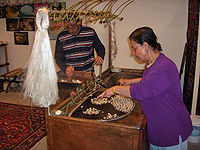
Silk's good absorbency makes it comfortable to wear in warm weather and while active. Its low conductivity keeps warm air close to the skin during cold weather. It is often used for clothing such as shirts, blouses, formal dresses, high fashion clothes, negligees, pyjamas, robes, skirtsuits, sun dresses and underwear.
Silk's elegant, soft luster and beautiful drape makes it perfect for many furnishing applications. It is used for upholstery, wall coverings, window treatments (if blended with another fiber), rugs, bedding and wall hangings.
While on the decline now, due to artificial fibers, silk has had many uses; parachutes, bicycle tires, comforter filling and artillery gunpowder bags. From the blackpowder era, until roughly World War I, early bulletproof vests were made from silk. A special manufacturing process makes it suitable as non-absorbable surgical sutures. Chinese doctors have used it to make prosthetic arteries. Silk cloth is also used as a material on which to write.
Production
The cultivation of silk is called sericulture. Over 30 countries produce silk, the major ones are China (54%) and India (14%).
| Top Ten Cocoons(Reelable) Producers — 2005 | ||||
|---|---|---|---|---|
| Country | Production (Int $1000) | Footnote | Production (MT) | Footnote |
| 978,013 | C | 290,003 | F | |
| 259,679 | C | 77,000 | F | |
| 57,332 | C | 17,000 | F | |
| 37,097 | C | 11,000 | F | |
| 20,235 | C | 6,000 | F | |
| 16,862 | C | 5,000 | F | |
| 10,117 | C | 3,000 | F | |
| 5,059 | C | 1,500 | F | |
| 3,372 | C | 1,000 | F | |
| 2,023 | C | 600 | F | |
| No symbol = official figure,F = FAO estimate, * = Unofficial figure, C = Calculated figure; Production in Int $1000 have been calculated based on 1999-2001 international prices |
||||
Cultivation
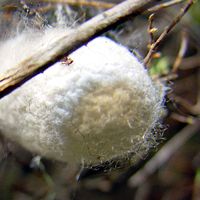
Silk moths lay eggs on specially prepared paper. The eggs hatch and the caterpillars (silkworms) are fed fresh mulberry leaves. After about 35 days and 4 moltings, the caterpillars are 10,000 times heavier than when hatched, and are ready to begin spinning a cocoon. A straw frame is placed over the tray of caterpillars, and each caterpillar begins spinning a cocoon by moving its head in a "figure 8" pattern. Two glands produce liquid silk and force it through openings in the head called spinnerets. Liquid silk is coated in sericin, a water-soluble protective gum, and solidifies on contact with the air. Within 2-3 days, the caterpillar spins about 1 mile of filament and is completely encased in a cocoon. Most caterpillars are then killed by heat and some are allowed to metamorphose into moths to breed the next generation of caterpillars.
Animal rights
As the process of harvesting the silk from the cocoon kills the larvae, sericulture has been criticized in the early 21st century by animal rights activists, especially since artificial silks are available.[8] Mahatma Gandhi was also critical of silk production based on the Ahimsa philosophy. Ahimsa is part of the three millennial Jain philosophy of India, "not to hurt any living thing". This led to development of a cotton spinning machine which Gandhi distributed and can be seen at the Gandhi Institute. Ahimsa Silk, made from the cocoons of wild and semi-wild silk moths, is promoted in parts of Southern India for those who prefer not to wear silk produced by killing silkworms.
See also
- Mommes, the traditional density unit for silk.
- Rayon
- Art silk
- Thai silk
- History of silk
- Silk Road
- Spider silk (with a discussion of synthetic silk)
- Tenun Pahang Diraja, famous woven silk fabric of Pahang, Malaysia.
- Silk in the Indian subcontinent
- International Year of Natural Fibres 2009
Footnotes
- ↑ 1.0 1.1 "Chinese archaeologists make ground-breaking textile discovery in 2,500-year-old tomb". People's Daily Online.. Retrieved on 2007-08-26.
- ↑ Hill, John E. 2003. "Annotated Translation of the Chapter on the Western Regions according to the Hou Hanshu." 2nd Edition. Appendix A. [1]
- ↑ About Thai silk from World of Thai Silk (commercial)
- ↑ Odyssey 19 233-234: τὸν δὲ χιτῶν' ἐνόησα περὶ χροῒ σιγαλόεντα, οἷόν τε κρομύοιο λοπὸν κάτα ἰσχαλέοιο· = "And I [= Odysseus
- ↑ Tacitus. Annals. http://www.gutenberg.org/etext/7959.
- ↑ "Silk: Why It Is Haram for Men" (2003-09-23). Retrieved on 2007-01-06.
- ↑ The Silkworm Museum, Meldola
- ↑ "Down and Silk: Birds and Insects Exploited for Fabric". PETA. Retrieved on 2007-01-06.
References
- Good, Irene. 1995. “On the question of silk in pre-Han Eurasia” Antiquity Vol. 69, Number 266, December 1995, pp. 959-968
- Hill, John E. 2004. The Peoples of the West from the Weilue 魏略 by Yu Huan 魚豢: A Third Century Chinese Account Composed between 239 and 265 AD. Draft annotated English translation. Appendix E. [3]
- Kuhn, Dieter. 1995. “Silk Weaving in Ancient China: From Geometric Figures to Patterns of Pictorial Likeness.” Chinese Science 12 (1995): pp. 77-114.
- Liu, Xinru. 1996. Silk and Religion: An Exploration of Material Life and the Thought of People, AD 600-1200. Oxford University Press.
- Sung, Ying-Hsing. 1637. Chinese Technology in the Seventeenth Century - T'ien-kung K'ai-wu. Translated and annotated by E-tu Zen Sun and Shiou-chuan Sun. Pennsylvania State University Press, 1966. Reprint: Dover, 1997. Chap. 2. Clothing materials.
- Kadolph, Sara J. Textiles. 10th ed. Upper Saddle River: Pearson Prentice Hall, 2007. 76-81.
External links
- Silkworm rearing (with photos)
- References to silk by Roman and Byzantine writers
- A series of maps depicting the global trade in silk
- Raw Silk Production and Silk Weaving
- History of traditional silk in martial arts uniforms
|
||||||||||||||||||
|
|||||||||||||||||||||||||||||||||||||

